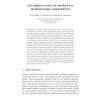Free Online Productivity Tools
i2Speak
i2Symbol
i2OCR
iTex2Img
iWeb2Print
iWeb2Shot
i2Type
iPdf2Split
iPdf2Merge
i2Bopomofo
i2Arabic
i2Style
i2Image
i2PDF
iLatex2Rtf
Sci2ools
IPMI
2001
Springer
2001
Springer
An Adaptive Level Set Method for Medical Image Segmentation
An efficient adaptive multigrid level set method for front propagation purposes in three dimensional medical image processing and segmentation is presented. It is able to deal with non sharp segment boundaries. A flexible, interactive modulation of the front speed depending on various boundary and regularization criteria ensure this goal. Efficiency is due to a graded underlying mesh implicitly defined via error or feature indicating values on the cells of the underlying hexahedral grid. A suitable saturation condition ensures an important regularity condition on the resulting adaptive grid. This simplifies the adaptive fast marching method on the compressed data significantly. As an application the segmentation of glioma is considered. Thus the clinician interactively selects a few parameters describing the speed function and a few seed points referring to a single slice of an MRI data set. Then the automatic process of front propagation generates a family of segments corresponding to...
Adaptive Fast Marching | Adaptive Multigrid Level | IPMI 2001 | Medical Imaging | Overall Glioma Segmentation |
| Added | 16 Nov 2009 |
| Updated | 16 Nov 2009 |
| Type | Conference |
| Year | 2001 |
| Where | IPMI |
| Authors | Marc Droske, Bernhard Meyer, Martin Rumpf, Carlo Schaller |
Comments (0)

